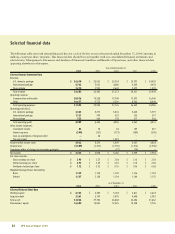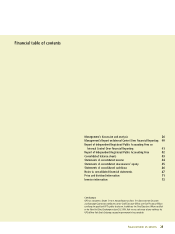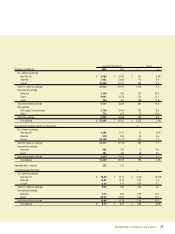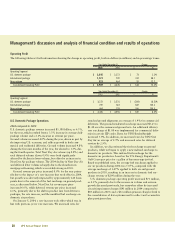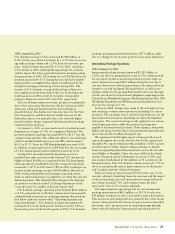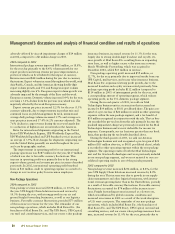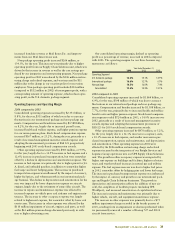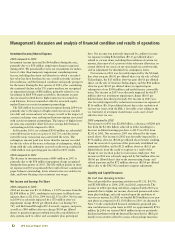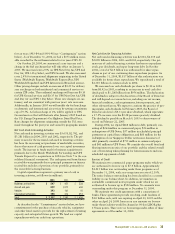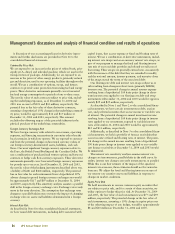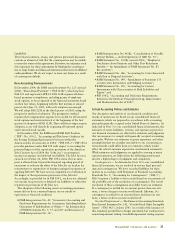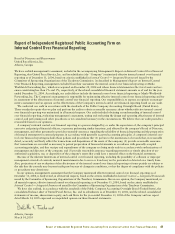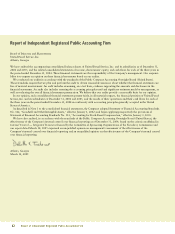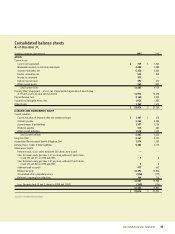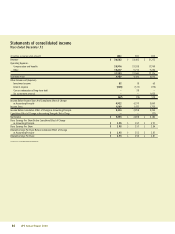UPS 2004 Annual Report Download - page 36
Download and view the complete annual report
Please find page 36 of the 2004 UPS annual report below. You can navigate through the pages in the report by either clicking on the pages listed below, or by using the keyword search tool below to find specific information within the annual report.
34 UPS Annual Report 2004
Management’s discussion and analysis of financial condition and results of operations
In August 2003, we filed a $2.0 billion shelf registration state-
ment under which we may issue debt securities in the United
States. There was approximately $126 million issued under this
shelf registration statement at December 31, 2004, all of which
consists of issuances under our UPS Notes program.
Our existing debt instruments and credit facilities do not have
cross-default or ratings triggers, however these debt instruments
and credit facilities do subject us to certain financial covenants.
These covenants generally require us to maintain a $3.0 billion
minimum net worth and limit the amount of secured indebtedness
available to the company. These covenants are not considered
material to the overall financial condition of the company, and all
covenant tests were passed as of December 31, 2004.
Commitments
We have contractual obligations and commitments in the form
of operating leases, capital leases, debt obligations and purchase
commitments. We intend to satisfy these obligations through the
use of cash flow from operations. The following table summa-
rizes our contractual obligations and commitments as of
December 31, 2004 (in millions):
Capitalized Operating Debt Purchase
Year Leases Leases Principal Commitments
2005 $ 97 $ 370 $ 1,110 $ 1,012
2006 70 327 6 488
2007 121 242 — 223
2008 132 169 27 274
2009 76 128 84 637
After 2009 62 590 2,777 1,129
Total $558 $ 1,826 $ 4,004 $ 3,763
In December 2004, we amended our existing aircraft purchase
agreement with Airbus Industries. The amended agreement will
reduce Airbus A300-600 aircraft on order from 50 to 13, and
the number of options on this aircraft from 37 to zero. These 13
aircraft remaining on order will be delivered to UPS by July
2006. Additionally, we placed a firm order for 10 Airbus A380
freighter aircraft, and obtained options to purchase 10 addi-
tional A380 aircraft. The Airbus A380 aircraft will be delivered
to UPS between 2009 and 2012. The purchase commitments
information above reflects the amended agreement.
In January 2005, we also announced an agreement to pur-
chase an additional 11 Boeing MD-11 pre-owned aircraft. These
aircraft will be delivered to UPS between 2005 and 2007.
We believe that funds from operations and borrowing pro-
grams will provide adequate sources of liquidity and capital
resources to meet our expected long-term needs for the operation
of our business, including anticipated capital expenditures, such
as commitments for aircraft purchases, for the foreseeable future.
Contingencies
On August 9, 1999 the United States Tax Court held that we
were liable for tax on income of Overseas Partners Ltd., a
Bermuda company that had reinsured excess value (“EV”) insur-
ance purchased by our customers beginning in 1984, and that we
were liable for additional tax for the 1983 and 1984 tax years.
The IRS took similar positions to those advanced in the Tax
Court decision for tax years subsequent to 1984 through 1998.
On June 20, 2001, the U.S. Court of Appeals for the Eleventh
Circuit ruled in our favor and reversed the Tax Court decision. In
January 2003, we and the IRS finalized settlement of all out-
standing tax issues related to EV package insurance. Under the
terms of settlement, we agreed to adjustments that will result in
income tax due of approximately $562 million, additions to tax
of $60 million and related interest. The amount due to the IRS as
a result of the settlement is less than amounts we previously had
accrued. As a result, we recorded income, before taxes, of $1.023
billion ($776 million after tax) during the fourth quarter of 2002.
In the first quarter of 2004, we received a refund of $185 million
pertaining to the 1983 and 1984 tax years.
The IRS had proposed adjustments, unrelated to the EV pack-
age insurance matters discussed above, regarding the allowance
of deductions and certain losses, the characterization of expenses
as capital rather than ordinary, the treatment of certain income,
and our entitlement to tax credits in the 1985 through 1998 tax
years. In the third quarter of 2004, we settled all outstanding
issues related to each of the tax years 1991 through 1998. In the
fourth quarter of 2004, we received a refund of $425 million
pertaining to the 1991 through 1998 tax years. We expect to
receive the $371 million of refunds related to the 1985 through
1990 tax years within the next six months.
The IRS may take similar positions with respect to some of
the non-EV package insurance matters for each of the years
1999 through 2004. If challenged, we expect that we will prevail
on substantially all of these issues. Specifically, we believe that
our practice of expensing the items that the IRS alleges should
have been capitalized is consistent with the practices of other
industry participants. We believe that the eventual resolution of
these issues will not have a material adverse effect on our finan-
cial condition, results of operations or liquidity.
We were named as a defendant in twenty-three now-dismissed
lawsuits that sought to hold us liable for the collection of premiums
for EV insurance in connection with package shipments since 1984.
Based on state and federal tort, contract and statutory claims, these
cases generally claimed that we failed to remit collected EV premi-
ums to an independent insurer; we failed to provide promised EV
insurance; we acted as an insurer without complying with state
insurance laws and regulations; and the price for EV insurance was
excessive. These actions were all filed after the August 9, 1999 U.S.
Tax Court decision, discussed above, which the U.S. Court of
Appeals for the Eleventh Circuit later reversed.


